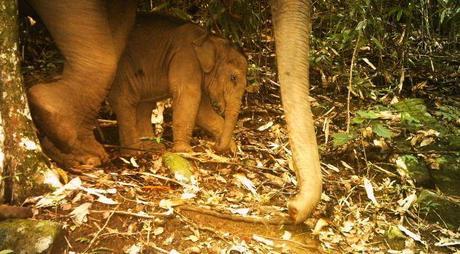“How does your research help baby elephants?” I thought it was a slightly strange and somewhat misplaced question to ask me. As conservation biologists, we focus on saving populations of animals and groups of species, rather than individual baby animals (though I would consider an exception for elephants – see the photos below and you’ll know what I mean). But I assured my questioner that my research was very ‘relephant’ to helping baby elephants. Like this little guy below, who is clearly throwing a tantrum, and refusing to move:
So why could he be throwing a tantrum? Well, an elephant’s life is not easy. They have to walk long distances in search of food and water, and watch out for predators and humans. That’s hard enough already for a calf, but it gets worse in the summer. Imagine that you were the bony elephant calf below, chewing on tasteless dry grass and bark, and getting sunburned in the merciless March sun:
And then, far away, through the heat haze and the forest fires, the matriarch of your herd spots a nice lake in the north-west!
You would probably jump with joy, dreaming about filling your stomach with juicy green grass, frolicking in the cooling slush, and spending long hours blissfully sleeping under your mother’s stomach:
Plus, for your entertainment, you can also charge any pesky researchers that are hanging around there, it would be hilarious. OK, so you wouldn’t jump with joy, because elephants can’t really jump, but you would surely at least smile and have a spring in your stride as you set off:
And so the whole herd eagerly gets moving to reach this promised land. There are many dangerous obstacles on the way: settlements and rubber plantations now stand in areas that were forests when your matriarch was a calf. And they are filled with people trying to make a living – who see you as a threat, and who will therefore drive you off if they see you nearby. But the herd is able to quietly sneak through the rubber plantations at night. The water is now getting closer and closer!
But then comes the most formidable obstacle of all. It is a highway, with steep embankments on both sides that are very difficult to safely cross. And, huge, noisy, smelly, steel monsters zoom by at breakneck speed every few seconds, day and night. All the herd members are nervous and agitated. You can see water just on the other side, but the matriarch decides it is much too dangerous to try to cross.
And so the herd turns back, tired, thirsty and disappointed. No wonder the calf is throwing a tantrum, I would too if I was him!
I may have made up the story above, but the situation is reality in much of India. For example, the photo below was taken at the spot where a tusker came down in February this year, to try and cross the highway (NH 208) that fragments the forest in the Shencottah Gap, my study site in Kerala. This is the first time a crossing attempt has been clearly recorded in ~20 years, as far as I know. But he couldn’t cross, and turned back. He appears to have tried last year too, unsuccessfully.
Interestingly, Chanakya, writing in the Arthashastra –
2200 years ago – apparently mandated a maximum road width of 4.5 m in elephant conservation forests, as opposed to 18 m in cities (The story of Asia’s elephants, Raman Sukumar). Some foresight on both counts, eh?
But what can you do about this? Stop building new highways? Clearly not. But what you can do, is mitigate them. Build the highway around rather than through the forest; or, build overpasses and underpasses so that animals – even elephants – can safely cross. The Kerala Forest Department has shown commitment to developing solutions to this problem in the Shencottah Gap. It will be a long and complex process, but I hope it works. We certainly don’t want to end up in the situation below (cartoon credit Rohan Chakravarty, Green Humour)! But in the meantime, if you are taking your annual pilgrimage to Sabarimala, and driving through NH 208, spare a thought for that thirsty elephant calf!













